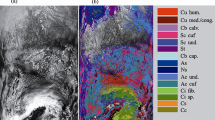Abstract—A statistical model is suggested for the physical parameters of different cloud types. This model has been developed through a comparison of MODIS thematic data with the results of global cloud field classification using neural network technology. The model is a set of one- and two-parametric distributions that describe fluctuations of physical parameters of different cloud types. The distribution parameters are estimated. The comparative analysis is carried out of the parameters under study for different cloud types. The features of different cloud types are determined. The statistical model developed is compared with similar works in this field and international databases; the results show their good consistency. The statistical model suggested can be regarded as a supplement to already existing cloud field models.




Similar content being viewed by others
REFERENCES
Aleksanin, A.I. and Kim, V., Automatic detection of internal waves on satellite images and assessment of the mixed layer density, Issled. Zemli Kosmosa, 2015, no. 1, pp. 44–52.
Astafurov, V.G. and Evsyutkin, T.V., A software system for the automatic classification of the texture of cirrus cloudiness on the basis of a neural-fuzzy network, Dokl. Tomsk. Gos. Univ. Sist. Upravl. Radioelektr., 2015, vol. 36, no. 2, pp. 125–129.
Astafurov, V.G. and Skorokhodov, A.V., Neural network technologies for classification of cloudiness by the texture of high-resolution MODIS images, Issled. Zemli Kosmosa, 2014, no. 5, pp. 39–49.
Astafurov, V.G. and Skorokhodov, A.V., Classification of multi-layer cloudiness from MODIS data using neural network technologies and the fuzzy logic approach, Sovrem. Probl. Distantsionnogo Zondirovaniya Zemli Kosmosa, 2015, vol. 12, no. 6, pp. 162–173.
Bespalov, D.P., Devyatkin, A.M., Dovgalyuk, Yu.A., Kondratyuk, V.I., Kuleshov, Yu.V., Svetlova, T.P., Suvorov, S.S., and Timofeev, V.I., Atlas oblakov (Atlas of Clouds), St. Petersburg: D’ART, 2011.
Chen, T., Rossow, W.B., and Zhang, Y., Radiative effects of cloud-type variations, J. Clim., 2000, vol. 13, no. 1, pp. 264–286.
Chernokulsky, A.V. and Mokhov, I.I., Comparative analysis of global and zonal cloudiness characteristics from different satellite and ground-based data, Issled. Zemli Kosmosa, 2010, no. 3, pp. 12–29.
EOS, NASA’s Earth Observing System Project Science Office, 1980–2016. http://eospso.nasa.gov. Accessed May 25, 2016.
Federal Service of Hydrometeorology and Environmental Monitoring (Rosgidromet), Code for the operational transmission of meteorological observation data from the Rosgidromet network of stations, Moscow: Triada, 2013.
ISCCP, International Satellite Cloud Climatology Project, 1982–2010. http://isccp.giss.nasa.gov. Accessed May 25, 2016.
Jakob, C., Cloud cover in the ECMWF reanalysis, J. Clim., 1999, vol. 12, no. 4, pp. 947–959.
Kharin, A.S., Luzan, P.I., Shatunova, M.V., and Dmitrieva-Arrago, L.R., Method for calculating the components of radiation energetics of the Earth–atmosphere system in the infrared spectral band, and the role of cloud microphysics, in Trudy Gidromettsentera Rossii (Proceedings of the Hydrometcenter of Russia), 2010, vol. 344, pp. 59–77.
LAADS WEB, Level 1 and Atmosphere Archive and Distribution System, 2000–2016. https://ladsweb.nascom. nasa.gov/index.html. Accessed May 25, 2016.
Mathwave. Data Analysis and Simulations, 2004–2016. http://www.mathwave.com/articles/distribution_fitting. html. Accessed May 25, 2016.
Matveev, L.T., On the causes of cloud formation, Meteorol. Gidrol., 1978, no. 8, pp. 25–31.
Matveev, L.T., Kurs obshhei meteorologii. Fizika atmosfery (Course of General Meteorology. Atmospheric Physics), Leningrad: Gidrometeoizdat, 1984.
MODIS-Atmosphere, U.S. Government Computer System, 2000–2016. http://modis-atmos.gsfc.nasa.gov. Accessed May 25, 2016.
NASA CERES, Clouds and the Earth’s Radiant Energy System Information and Data, 1999–2016. http:// ceres.larc.nasa.gov. Accessed May 25, 2016.
Norris, J.R., Multidecadal changes in near-global cloud cover and estimated cloud cover radiative forcing, J. Geophys. Res., 2005, vol. 110, D08206. doi 10.1029/2004JD005600
Nunalee, C.G. and Basu, S., On the periodicity of atmospheric von Karman vortex streets, Environ. Fluid Mech., 2014, vol. 14, no. 6, pp. 1335–1355.
Oblaka i oblachnaya atmosfera. Spravochnik (Clouds and Cloudy Atmosphere. A Reference Book), Mazin, A.Kh. and Khrgian, A.Kh., Leningrad: Gidrometeoizdat, 1989.
OGIMET, Professional information about meteorological conditions in the world, 2005–2016. http://www. ogimet.com/home.phtml.en. Accessed May 25, 2016.
Prokhorov, S.A., Lezin, I.A., and Soldatova, I.V., Approximation of distribution laws with orthogonal polynomials, Vestn. Samarsk. Gos. Tekh. Univ., Ser. Fiz.-Mat. Nauki, 2005, no. 34, pp. 128–136.
Quante, M., The role of clouds in the climate system, J. Phys IV France, 2004, vol. 121, pp. 61–86.
Shakina, N.P., Gorlach, I.A., Skriptunova, E.N., and Komas’ko, N.I., Icing of aircraft engines in ice crystal clouds: A case study, Russ. Meteorol. Hydrol., 2014, vol. 39, no. 2, pp. 121–125.
SSEC, Space Science and Engineering Data Center, 2005–2016. http://www.ssec.wisc.edu/datacenter/. Accessed May 25, 2016.
Volkova, E.V. and Uspenskiy, Assessment of daytime cloud-cover parameters from METEOSAT-8 geostationary satellite data, Sovrem. Probl. Distantsionnogo Issled. Zemli Kosmosa, 2008, vol. 1, no. 5, pp. 441–450.
Wylie, D.P., Menzel, W.P., Woolf, H.M., and Strabala, K.I., For years of global cirrus cloud statistics using HIRS, J. Clim., 1994, vol. 7, no. 12, pp. 1972–1986.
ACKNOWLEDGMENTS
The work was supported by the Russian Foundation for Basic Research (project no. 16-37-60019 mol_a_dk).
Author information
Authors and Affiliations
Corresponding author
Additional information
Translated by O. Ponomareva
Rights and permissions
About this article
Cite this article
Astafurov, V.G., Skorokhodov, A.V. Statistical Model of Physical Parameters of Clouds Based on MODIS Thematic Data. Izv. Atmos. Ocean. Phys. 54, 1202–1213 (2018). https://doi.org/10.1134/S0001433818090049
Received:
Published:
Issue Date:
DOI: https://doi.org/10.1134/S0001433818090049




